Sinkhole Detection and Characterization Using LiDAR-Derived DEM with Logistic Regression
Abstract
1. Introduction
2. Study Area
3. Methodology
3.1. Data Preparation
- Slope: Slope is one of the most important factors in hydrology because it is related to surface and subsurface flow velocity and runoff rate over the area of interest [34,35]. As slope increases, time for surface infiltration decreases, resulting in an increase in soil erosion. In this study area, the slope ranges from 0 to 81.6° (0 to 680% in percent rise). Steep slopes are located within the southwest area along the Little Sac River.
- Closed depression (CD): The boundary of a depression is defined as the spatial extent of maximum water surface level when the depression is filled with flood water and then starts spilling out. Therefore, a closed depression can be a significant indicator of a sinkhole boundary in karst landscapes.
- Valley depth (VD): VD is the vertical height below summit accumulation [38]. It ranged from 0 to 27 m for the study area.
- Convergence index (CI50, 50-m search radius): CI50 is used to determine whether water flow from neighboring cells diverges or converges. Convergence is calculated using flow direction between adjacent cells based on the aspects of neighboring cells [40].
- Convergence index (CI100, 100-m search radius): The same CI but the search radius of 100 m was used.
- Mid-slope position (MSP): MSP has values ranging from 0 (minimum slope) to 1 (maximum vertical distance from valley bottom or ridge top, i.e., valleys and crests) [41].
- Multiresolution index of valley bottom flatness (MRVBF): MRVBF is a measure of flatness and lowness depicting depositional areas [42]. Higher values correspond to larger valleys. It ranged from 0 to 4.99 for the study area.
- Multiresolution ridge top flatness index (MRRTF): MRRTF is a measure of flatness and elevation, depicting stable upland areas [42]. Higher values correspond to ridges. It ranged from 0 to 5.67 for the study area.
- Mass balance index (MBI): MBI is derived from transformed elevation, slope, and mean curvature. Positive values indicate convex forms (upper slopes, crests) whereas negative values indicate concave forms (valleys and lower slopes) [43].
- Topographic position index (TPI): TPI is the difference between a raster cell elevation and the average elevation of neighboring cells. TPI is calculated as:where is the elevation at a central point and is the mean surrounding elevation. Positive TPI values denote that the cell is located higher than its average neighborhood, whereas negative values denote that the cell is in lower position [35,44].
- Topographic wetness index (TWI): TWI combines the local upslope contributing area and slope. TWI is calculated as:where α is the upslope catchment area per unit contour length and β is the local slope gradient in percentage. High values indicate drainage depressions whereas low values indicate crest and ridges [45]. For more detailed information, you can find them at Supplementary Materials.
3.2. GLM Model Selection—Logistic Regression
3.3. Variable Selection
4. Results and Discussion
4.1. Variable Selection
4.2. Cutoff Value
4.3. Sinkhole Susceptibility Map (Cutoff = 0.13)
4.4. Sinkhole Geometric Characterization
5. Conclusions
- (1)
- The sinkhole detection and characterization techniques were proposed using the LiDAR-derived DEM data. The proposed algorithm is believed to allow for improved consistency and repeatability.
- (2)
- Sixteen geomorphometric parameters were derived from DEM data, and a test for multicollinearity was conducted using both the Spearman correlation coefficient and VIF criteria. As a result, seven out of sixteen parameters were found to be highly correlated and were excluded in the further analyses. The selected nine parameters were DEM, aspect, plan curvature, profile curvature, slope height, valley depth, MRVBF, MBI, and TWI.
- (3)
- Logistic regression was used to construct the probabilistic sinkhole susceptibility map using the reported sinkhole inventory. In order to define the appropriate sinkhole boundaries from the probabilistic sinkhole susceptibility map, it is important to determine the optimal cutoff value. In this study, the recommended cutoff value was calculated to be 0.13, which has maximum sensitivity and specificity values at the same time.
- (4)
- The proposed sinkhole susceptibility map with the recommended cutoff value well predicted the reported sinkhole boundaries. While the model achieved a considerably high AUC of 0.90, the cutoff value is based on a training dataset of the study area, making the current results limited to the study area, and might not be applicable elsewhere.
- (5)
- Geometric features of sinkholes such as length, width, depth, perimeter, area, volume, elongatedness, and circularity can be estimated with the proposed sinkhole susceptibility map and LiDAR data.
- (6)
- Significant benefits of this study may include (1) identification of non-inventoried (e.g., newly formed or previously non-detected) sinkholes in the database, (2) automatic delineation of sinkhole boundaries, and (3) quantification of a sinkhole’s geometric characteristics.
Supplementary Materials
Author Contributions
Funding
Acknowledgments
Conflicts of Interest
References
- Weary, D.J. The Cost of Karst Subsidence and Sinkhole Collapse in the United States Compared with Other Natural Hazards. In Proceedings of the 14th Multidisciplinary Conference on Sinkholes and the Engineering and Environmental Impacts of Karst, Rochester, MN, USA, 5–9 October 2015; pp. 433–446. [Google Scholar]
- Kuniansky, E.L.; Weary, D.J.; Kaufmann, J.E. The current status of mapping karst areas and availability of public sinkhole-risk resources in karst terrains of the United States. Hydrogeol. J. 2016, 24, 613–624. [Google Scholar] [CrossRef]
- Florida Office of Insurance Regulation. Report on Review of the 2010 Sinkhole Data Call. Available online: http://www.floir.com/siteDocuments/Sinkholes/2010_Sinkhole_Data_Call_Report.pdf (accessed on 3 July 2010).
- Gutiérrez, F.; Guerrero, J.; Lucha, P. A genetic classification of sinkholes illustrated from evaporite paleokarst exposures in Spain. Environ. Geol. 2008, 53, 993–1006. [Google Scholar] [CrossRef]
- Gutiérrez, F.; Parise, M.; De Waele, J.; Jourde, H. A review on natural and human-induced geohazards and impacts in karst. Earth Sci. Rev. 2014, 138, 61–88. [Google Scholar] [CrossRef]
- Ford, D.; Williams, P. Karst Hydrogeology and Geomorphology; John Wiley & Sons: New York, NY, USA, 2007; p. 562. [Google Scholar] [CrossRef]
- Williams, P.W. The role of the subcutaneous zone in karst hydrology. J. Hydrol. 1983, 61, 45–67. [Google Scholar] [CrossRef]
- Williams, P.W. Subcutaneous hydrology and the development of doline and cockpit karst. Z. Fur Geomorphol. 1985, 29, 463–482. [Google Scholar]
- Williams, P.W. Morphometric Analysis of Polygonal Karst in New Guinea. Geological. Soc. Am. Bull. 1972, 83, 761–796. [Google Scholar] [CrossRef]
- Lavalle, P. Some aspects of linear karst depression development in South Central Kentucky. Ann. Assoc. Am. Geogr. 1967, 57, 49–71. [Google Scholar] [CrossRef]
- Gutiérrez-Santolalla, F.; Gutiérrez-Elorza, M.; Marín, C.; Maldonado, C.; Younger, P.L. Subsidence hazard avoidance based on geomorphological mapping in the Ebro River valley mantled evaporite karst terrain (NE Spain). Environ. Geol. 2005, 48, 370–383. [Google Scholar] [CrossRef]
- Podobnikar, T.; Schöner, M.; Jansa, J.; Pfeifer, N. Spatial analysis of anthropogenic impact on karst geomorphology (Slovenia). Environ Geol. 2009, 58, 257–268. [Google Scholar] [CrossRef]
- Kobler, A.; Pfeifer, N.; Ogrinc, P.; Todorovski, L.; Oštir, K.; Džeroski, S. Repetitive interpolation: A robust algorithm for DTM generation from Aerial Laser Scanner Data in forested terrain. Remote Sens. Environ. 2007, 108, 9–23. [Google Scholar] [CrossRef]
- Hofton, M.A.; Rocchio, L.E.; Blair, J.B.; Dubayah, R. Validation of Vegetation Canopy Lidar sub-canopy topography measurements for a dense tropical forest. J. Geodyn. 2002, 34, 491–502. [Google Scholar] [CrossRef]
- Wu, Q.; Deng, C.; Chen, Z. Automated delineation of karst sinkholes from LiDAR-derived digital elevation models. Geomorphology 2016, 266, 1–10. [Google Scholar] [CrossRef]
- Gutiérrez, F.; Galve, J.P.; Lucha, P.; Castañeda, C.; Bonachea, J.; Guerrero, J. Integrating geomorphological mapping, trenching, InSAR and GPR for the identification and characterization of sinkholes: A review and application in the mantled evaporite karst of the Ebro Valley (NE Spain). Geomorphology 2011, 134, 144–156. [Google Scholar] [CrossRef]
- Filin, S.; Baruch, A.; Avni, Y.; Marco, S. Sinkhole characterization in the Dead Sea area using airborne laser scanning. Nat. Hazards 2011, 58, 1135–1154. [Google Scholar] [CrossRef]
- Kobal, M.; Bertoncelj, I.; Pirotti, F.; Dakskobler, I.; Kutnar, L. Using Lidar Data to Analyse Sinkhole Characteristics Relevant for Understory Vegetation under Forest Cover—Case Study of a High Karst Area in the Dinaric Mountains. PLoS ONE 2015, 10, e0122070. [Google Scholar] [CrossRef] [PubMed]
- Mukherjee, A.; Zachos, L.G. GIS Analysis of Sinkhole Distribution in Nixa, Missouri. In Proceedings of the GSA Annual Meeting & Exposition, Charlotte, NC, USA, 4–7 November 2012; p. 549. [Google Scholar]
- Zhu, J.; Taylor, T.P.; Currens, J.C.; Crawford, M.M. Improved Karst Sinkhole Mapping in Kentucky using LiDAR Techniques: A Pilot Study in Floyds Fork Watershed. J. Cave Karst Stud. 2014, 76, 207–216. [Google Scholar] [CrossRef]
- Obu, J.; Podobnikar, T. Algorithm for karst depression recognition using digital terrain models. Geod. Vestn. 2013, 57, 260–270. [Google Scholar] [CrossRef]
- Rahimi, M.; Alexander, E.C., Jr. Locating Sinkholes in LiDAR Coverage of a Glacio-Fluvial Karst, Winona County, MN. In Proceedings of the 13th Multidisciplinary Conference on Sinkholes and the Engineering and Environmental Impacts of Karst, Carlsbad, New Mexico, 6–10 May 2013; pp. 469–480. [Google Scholar]
- Sarkar, T.; Mishra, M. Soil Erosion Susceptibility Mapping with the Application of Logistic Regression and Artificial Neural Network. J. Geovisualization Sp. Anal. 2018, 2, 8. [Google Scholar] [CrossRef]
- Mousavi, S.Z.; Kavian, A.; Soleimani, K.; Mousavi, S.R.; Shirzadi, A. GIS-based spatial prediction of landslide susceptibility using logistic regression model. Geomat. Naturals Hazards Risk 2011, 2, 33–50. [Google Scholar] [CrossRef]
- Shafapour Tehrany, M.; Shabani, F.; Neamah Jebur, M.; Hong, H.; Chen, W.; Xie, X. GIS-based spatial prediction of flood prone areas using standalone frequency ratio, logistic regression, weight of evidence and their ensemble techniques. Geomat. Naturals Hazards Risk 2017, 8, 1538–1561. [Google Scholar] [CrossRef]
- Junek, W.N.; Jones, L.W.; Woods, M.T. Use of Logistic Regression for Forecasting Short-Term Volcanic Activity. Algorithms 2012, 5, 330–363. [Google Scholar] [CrossRef]
- Kim, K.; Kim, J.; Kwak, T.-Y.; Chung, C.-K. Logistic regression model for sinkhole susceptibility due to damaged sewer pipes. Nat. Hazards 2018, 93, 765–785. [Google Scholar] [CrossRef]
- Lamelas, M.T.; Marinoni, O.; Hoppe, A.; de la Riva, J. Doline probability map using logistic regression and GIS technology in the central Ebro Basin (Spain). Environ. Geol. 2008, 54, 963–977. [Google Scholar] [CrossRef]
- Ozdemir, A. Sinkhole susceptibility mapping using logistic regression in Karapınar (Konya, Turkey). Bull. Eng. Geol. Environ. 2016, 75, 681–707. [Google Scholar] [CrossRef]
- Missouri Department of Natural Resources. Missouri Geological Survey. Available online: https://dnr.mo.gov/geology/geosrv/envgeo/sinkholes.htm (accessed on 8 April 2019).
- Missouri Spatial Data Information Service. Missouri LiDAR Data; LiDAR DEM Download Tool. Available online: http://msdis.missouri.edu/data/lidar/ (accessed on 27 March 2019).
- Greene County, Missouri; 2011 Digital Mapping Project; LiDAR & Survey Report; Greene County. Available online: ftp://lidar.wustl.edu/Greene/0196%20Greene_County_LiDAR_Final_Report.pdf (accessed on 3 July 2019).
- Conrad, O.; Bechtel, B.; Bock, M.; Dietrich, H.; Fischer, E.; Gerlitz, L.; Wehberg, J.; Wichmann, V.; Böhner, J. System for Automated Geoscientific Analyses (SAGA) v. 2.1.4. Geosci. Model Dev. 2015, 8, 1991–2007. [Google Scholar] [CrossRef]
- Zevenbergen, L.W.; Thorne, C.R. Quantitative analysis of land surface topography. Earth Surf. Proc. Landf. 1987, 12, 47–56. [Google Scholar] [CrossRef]
- Wilson, J.P.; Gallant, J.C. Primary Topographic Attributes. In Terrain Analysis: Principles and Applications; Wilson, J.P., Gallant, J.C., Eds.; John Wiley & Sons: Hoboken, NJ, USA, 2000; pp. 51–85. [Google Scholar]
- Xu, C.; Xu, X.; Dai, F.; Saraf, A.K. Comparison of different models for susceptibility mapping of earthquake triggered landslides related with the 2008 Wenchuan earthquake in China. Comput. Geosci. 2012, 46, 317–329. [Google Scholar] [CrossRef]
- Mancini, F.; Ceppi, C.; Ritrovato, G. GIS and statistical analysis for landslide susceptibility mapping in the Daunia area, Italy. Nat. Hazards Earth Syst. Sci. 2010, 10, 1851–1864. [Google Scholar] [CrossRef]
- Böhner, J.; Selige, T. Spatial Prediction of Soil Attributes Using Terrain Analysis and Climate Regionalization. Available online: https://www.researchgate.net/publication/267821689_Spatial_prediction_of_soil_attributes_using_terrain_analysis_and_climate_regionalization (accessed on 2 July 2019).
- Böhner, J.; Antonić, O. Chapter 8 Land-Surface Parameters Specific to Topo-Climatology. In Developments in Soil Science; Hengl, T., Reuter, H.I., Eds.; Elsevier: Amsterdam, The Netherlands, 2009; Volume 33, pp. 195–226. [Google Scholar]
- Köthe, R.; Lehmeier, F. SARA— System zur Automatischen Relief-Analyse, Benutzerhandbuch; Department of Geography, University of Göttingen: Göttingen, Germany, 1996; p. 24. [Google Scholar]
- Dietrich, H.; Böhner, J. Cold Air Production and Flow in a Low Mountain Range Landscape in Hessia (Germany). In SAGA–Seconds Out, Hamburger Beiträge zur Physischen Geographie und Landschaftsökologie; University Hamburg, Institut für Geographie: Hamburg, Germany, 2008; Volume 19, pp. 37–48. [Google Scholar]
- Gallant, J.C.; Dowling, T.I. A multiresolution index of valley bottom flatness for mapping depositional areas. Water Res. Res. 2003, 39. [Google Scholar] [CrossRef]
- Möller, M.; Volk, M.; Friedrich, K.; Lymburner, L. Placing soil-genesis and transport processes into a landscape context: A multiscale terrain-analysis approach. J. Plant Nutr. Soil Sci. 2008, 171, 419–430. [Google Scholar] [CrossRef]
- Guisan, A.; Weiss, S.B.; Weiss, A.D. GLM versus CCA spatial modeling of plant species distribution. Plant Ecol. 1999, 143, 107–122. [Google Scholar] [CrossRef]
- Beven, K.J.; Kirkby, M.J. A physically based, variable contributing area model of basin hydrology Un modèle à base physique de zone d’appel variable de l’hydrologie du bassin versant. Hydrol. Sci. Bull. 1979, 24, 43–69. [Google Scholar] [CrossRef]
- Guisan, A.; Edwards, T.C.; Hastie, T. Generalized linear and generalized additive models in studies of species distributions: Setting the scene. Ecol. Modellier 2002, 157, 89–100. [Google Scholar] [CrossRef]
- Franklin, J. Mapping Species Distributions: Spatial Inference and Prediction; Cambridge University Press: Cambridge, UK, 2010. [Google Scholar] [CrossRef]
- Myers, R.H.; Montgomery, D.; Vining, G.G.; Robinson, T.J. Generalized Linear Models: With Applications in Engineering and the Sciences, 2nd ed.; John Wiley and Sons Inc.: New York, NY, USA, 2012. [Google Scholar] [CrossRef]
- Hosmer, D.W.; Jovanovic, B.; Lemeshow, S. Best Subsets Logistic Regression. Biometrics 1989, 45, 1265–1270. [Google Scholar] [CrossRef]
- Schwarz, G. Estimating the Dimension of a Model. Ann. Stat. 1978, 6, 461–464. [Google Scholar] [CrossRef]
- Akaike, H. A new look at the statistical model identification. IEEE Trans. Autom. Control. 1974, 19, 716–723. [Google Scholar] [CrossRef]
- Field, A. Discovering Statistics Using SPSS, 2nd ed.; Sage Publications, Inc.: Thousand Oaks, CA, USA, 2005; p. xxxiv, 779. [Google Scholar]
- Quinn, G.P.; Keough, M.J. Experimental Design and Data Analysis for Biologists; Cambridge University Press: Cambridge, UK, 2002. [Google Scholar] [CrossRef]
- Hair, J.F., Jr.; Black, W.C.; Babin, B.J.; Anderson, R.E. Multivariate Data Analysis, 7th ed.; Prentice-Hall: Upper Saddle River, NJ, USA, 2010. [Google Scholar]
- Hosmer, D.W., Jr.; Lemeshow, S.; Sturdivant, R.X. Applied Logistic Regression, 3rd ed.; John Wiley & Sons, Inc.: Hoboken, NJ, USA, 2013; Volume 398, p. 528. [Google Scholar]
- Altman, D.G.; Bland, J.M. Diagnostic tests. 1: Sensitivity and specificity. BMJ 1994, 308, 1552. [Google Scholar] [CrossRef] [PubMed]
- Pratt, W.K. Digital Image Processing: PIKS Scientific Inside, 4th ed.; John Wiley & Sons, Inc.: New York, NY, USA, 2006. [Google Scholar]
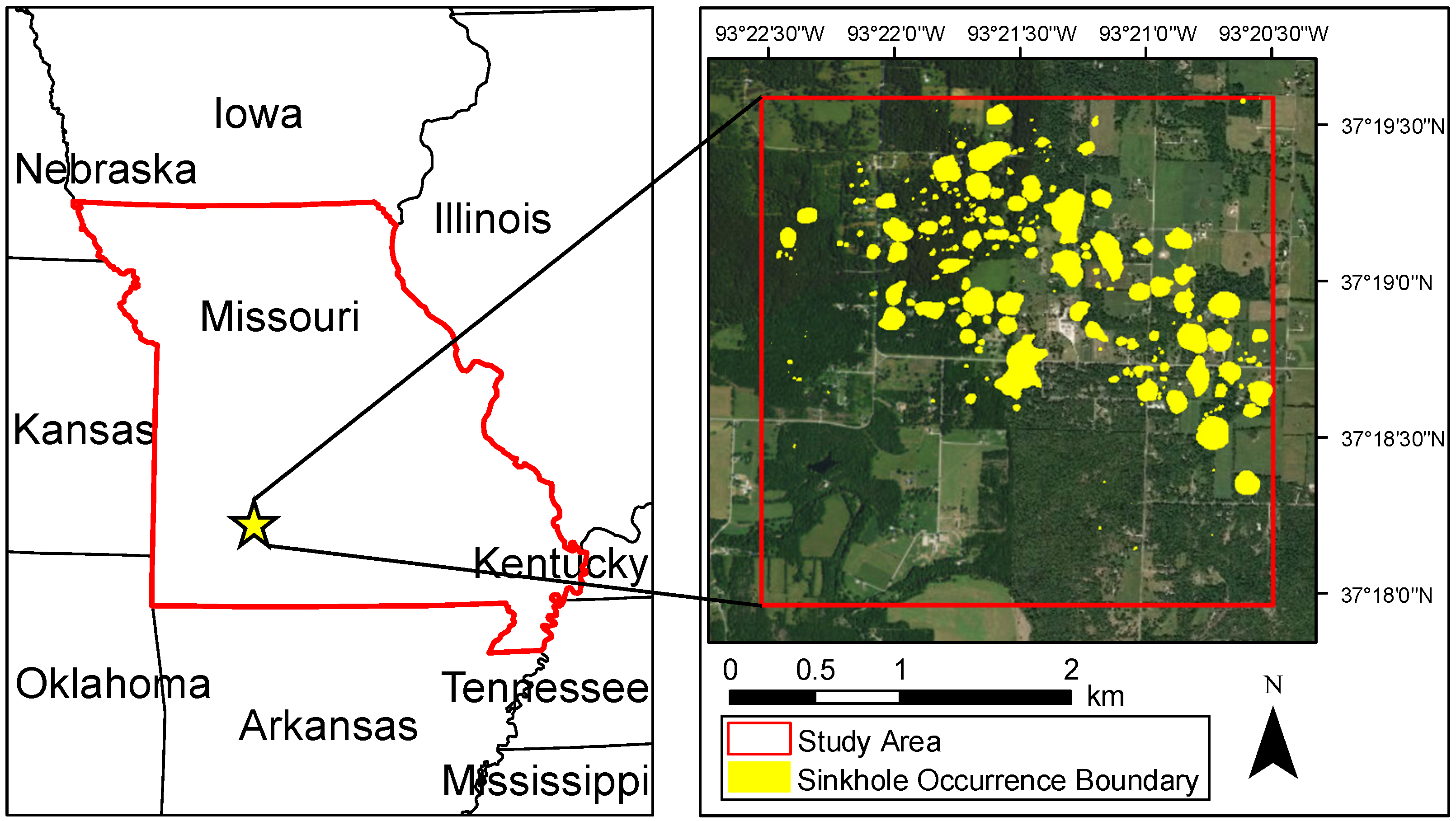
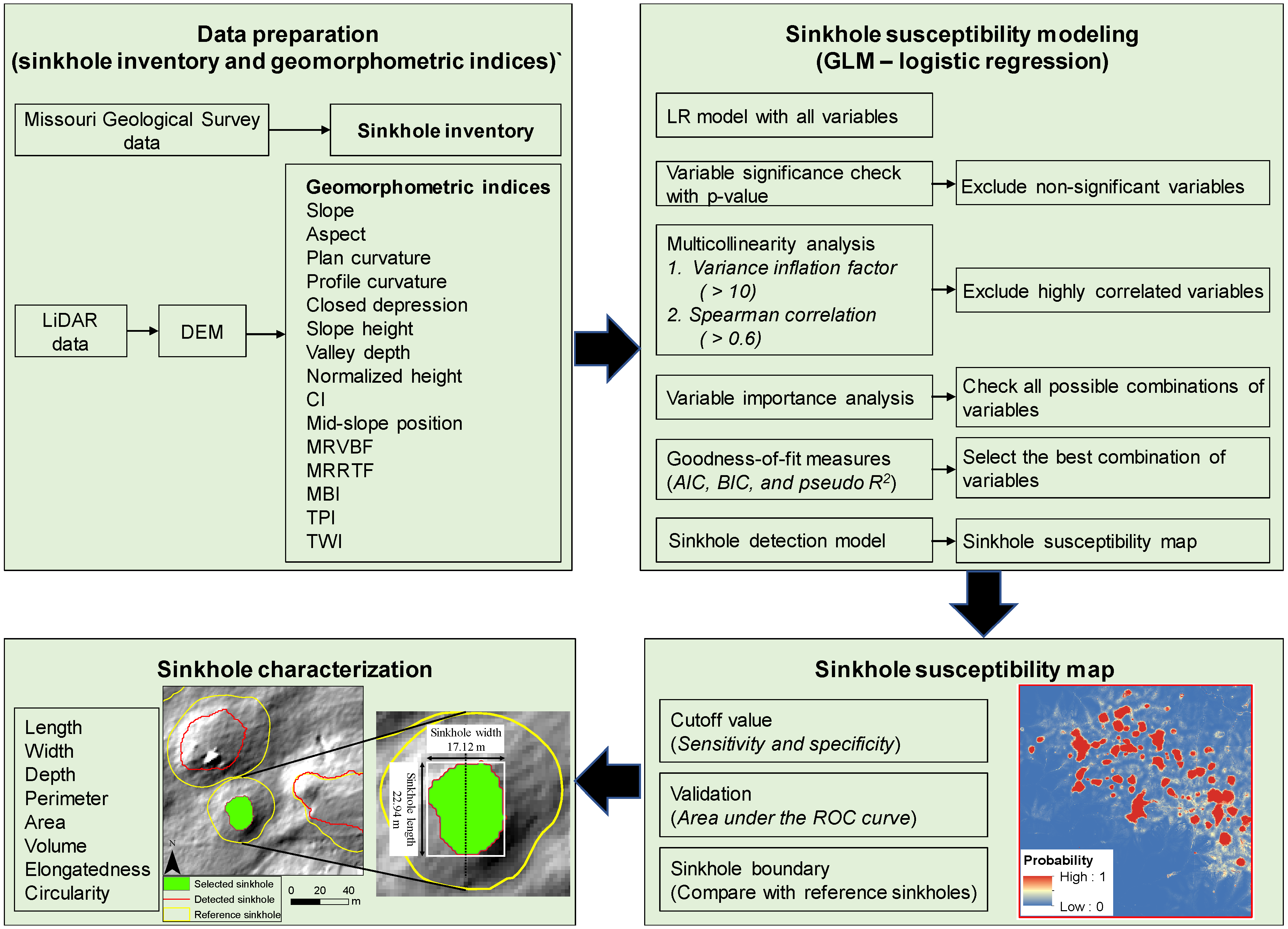
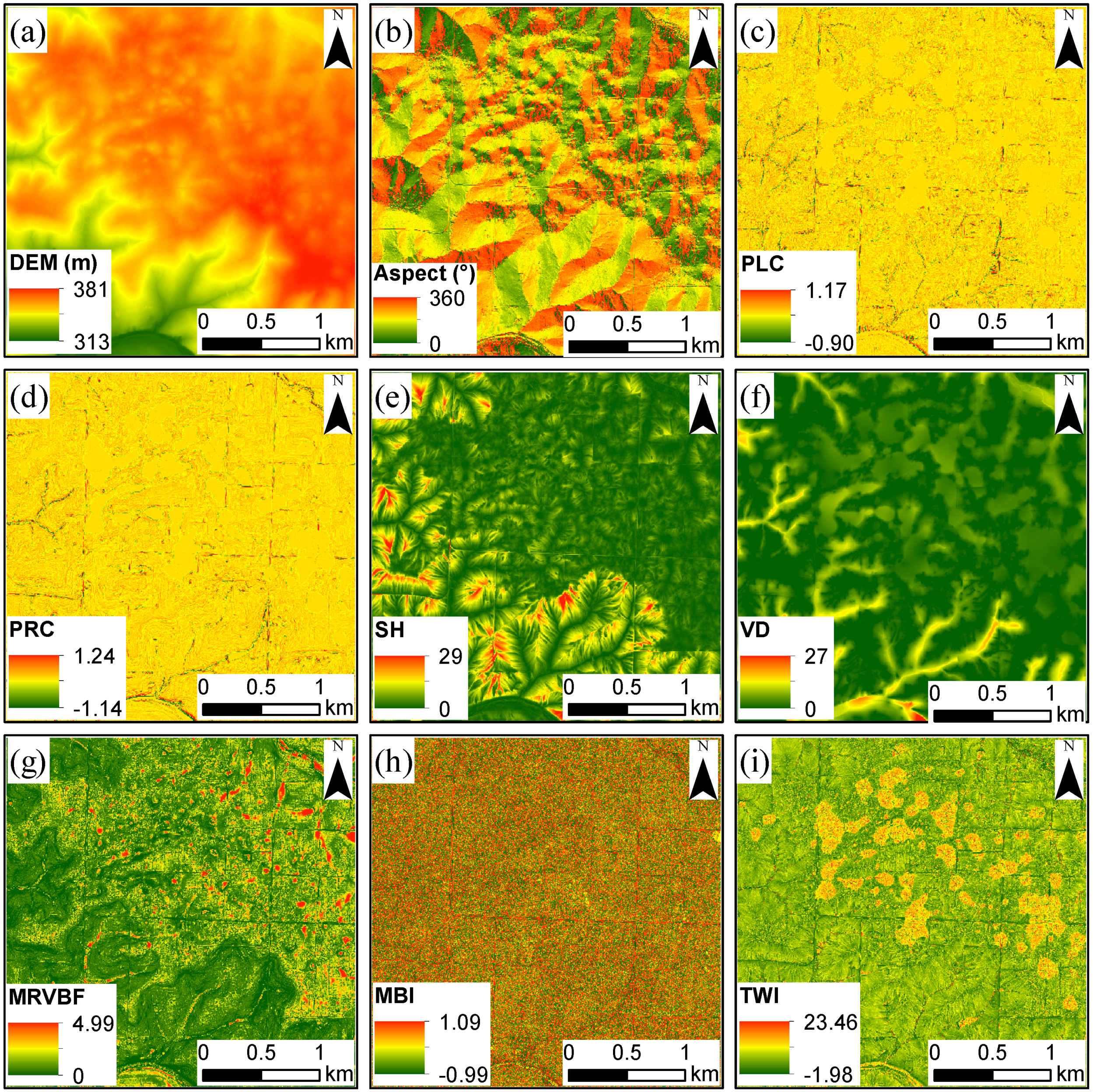

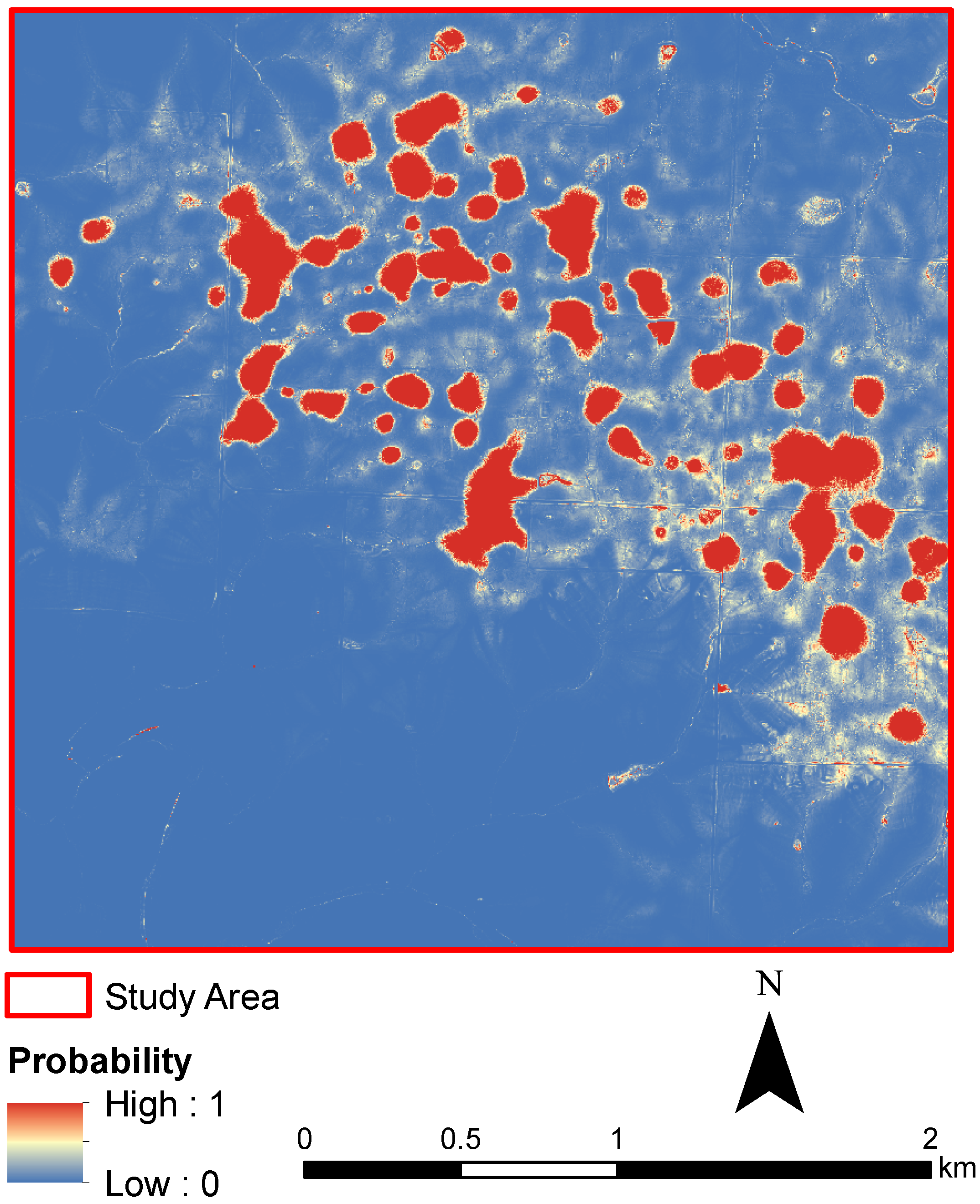
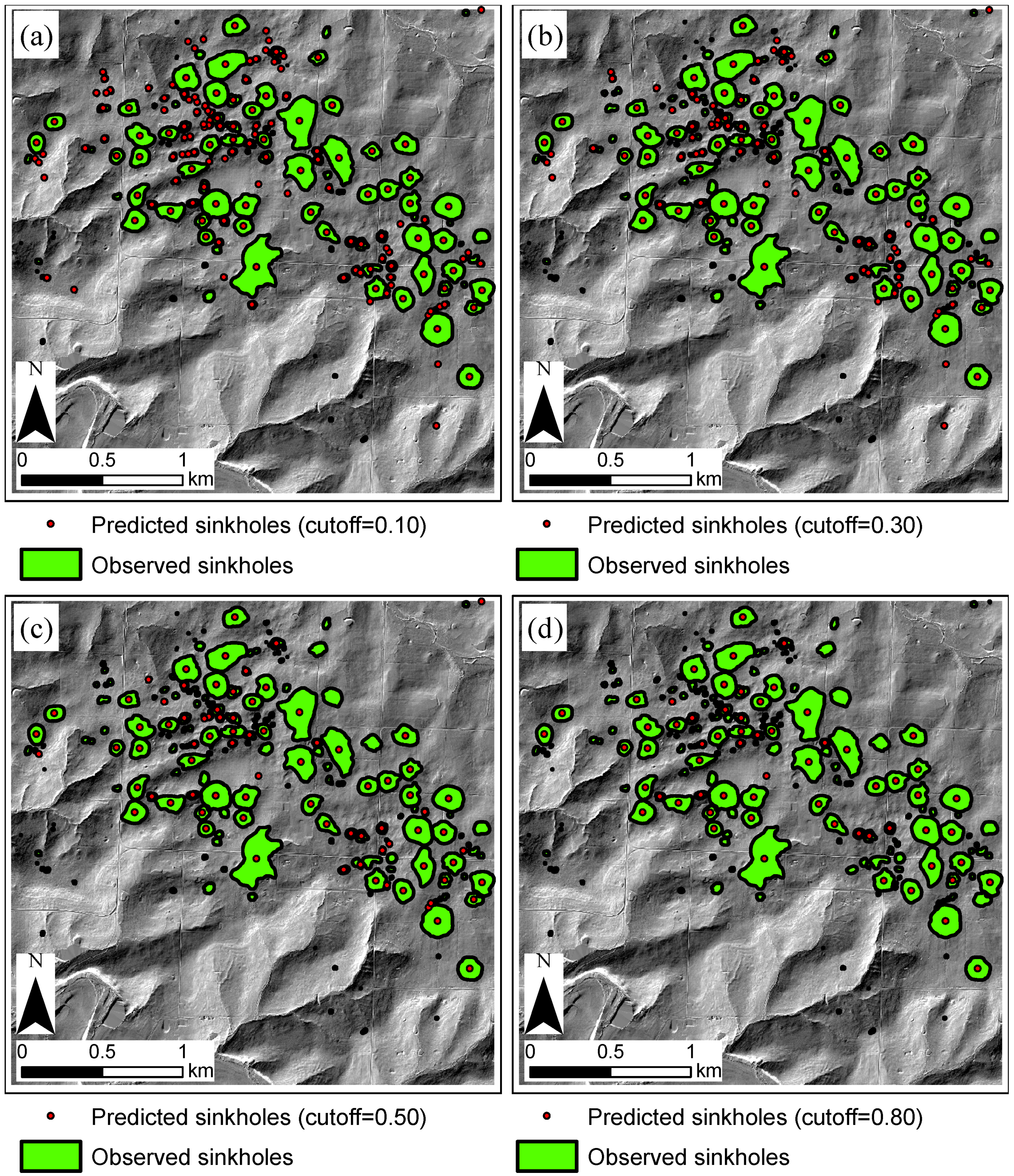
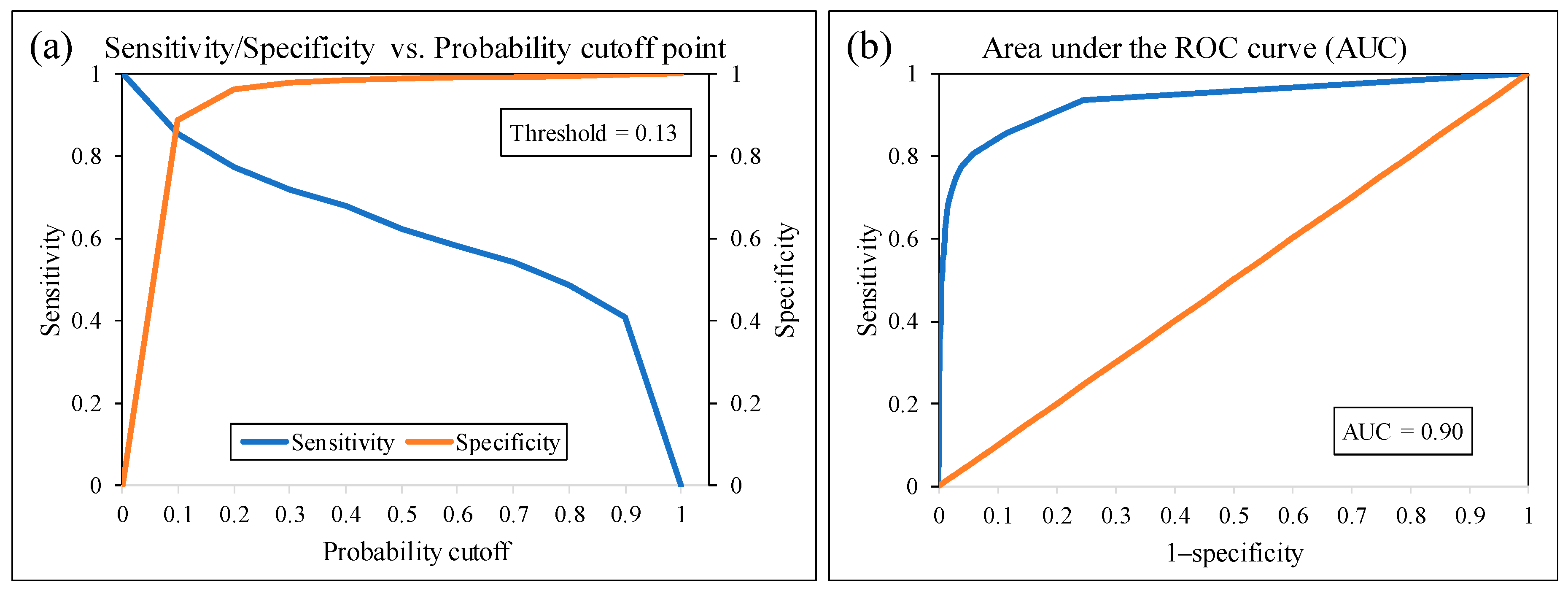
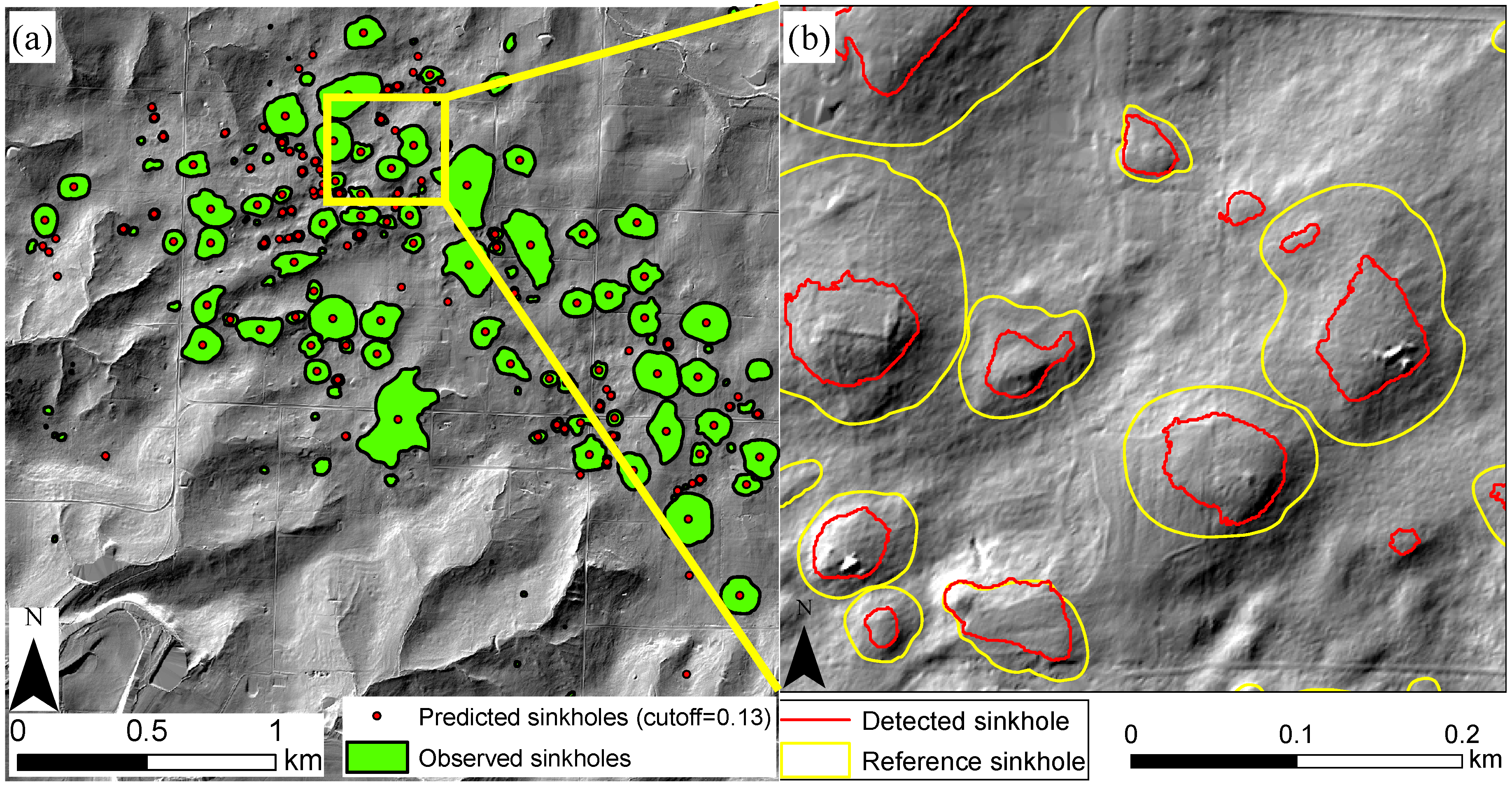
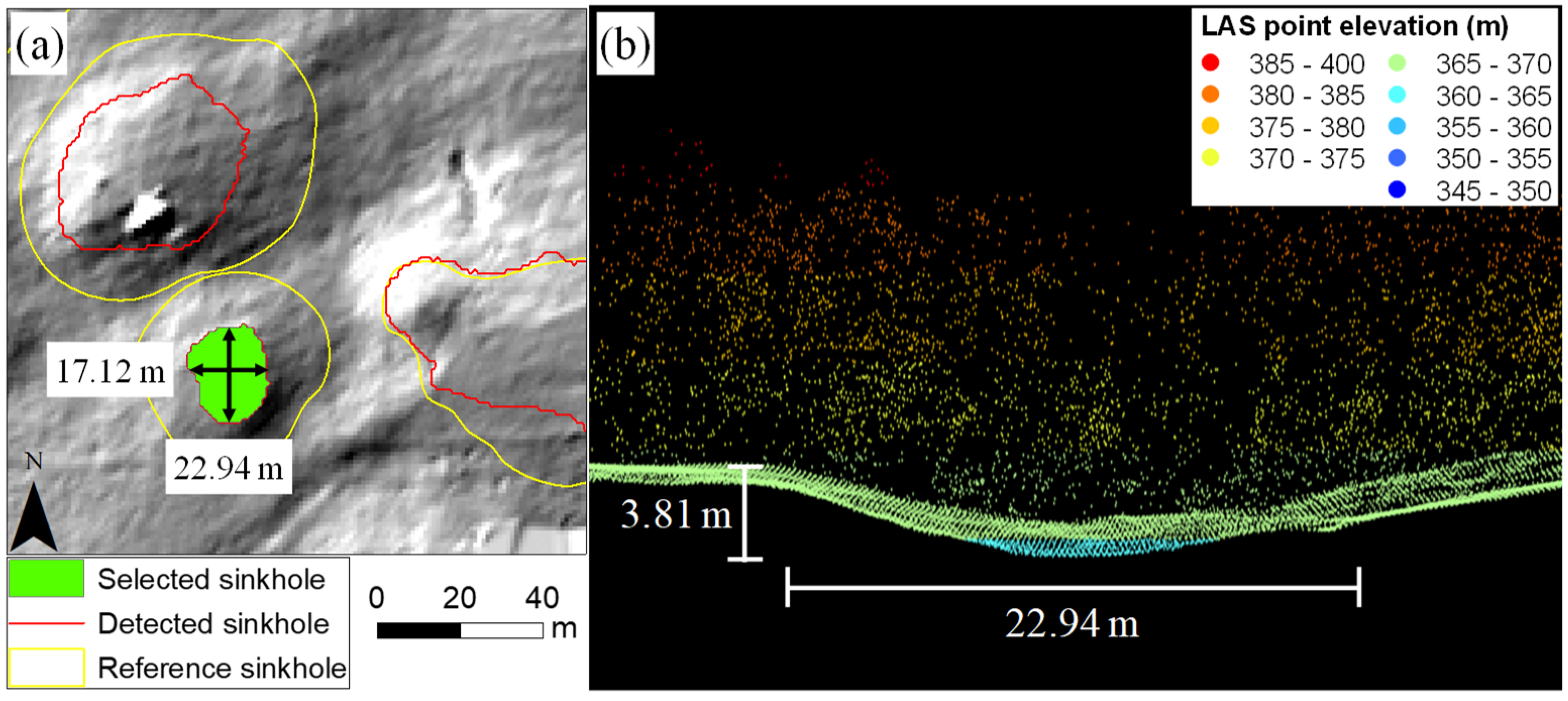
| Model | Variable | Estimate | Std. Error | Wald Statistic | p Value |
|---|---|---|---|---|---|
| 1 | (Intercept) | −42.3300 | 0.0825 | −513.36 | <0.001 |
| DEM | 0.1049 | 0.0002 | 477.55 | <0.001 | |
| Aspect | −0.0006 | 0.0000 | −45.16 | <0.001 | |
| PLC | 20.9700 | 0.1549 | 135.37 | <0.001 | |
| PRC | −5.5740 | 0.1141 | −48.87 | <0.001 | |
| SH | −0.6034 | 0.0016 | −385.24 | <0.001 | |
| VD | 0.0948 | 0.0010 | 95.37 | <0.001 | |
| MSP | 0.0160 | 0.0053 | 3.03 | 0.00245 | |
| MRVBF | −0.7296 | 0.0019 | −384.52 | <0.001 | |
| MBI | 0.3363 | 0.0020 | 170.92 | <0.001 | |
| TWI | 0.5554 | 0.0006 | 900.12 | <0.001 | |
| 2 | (Intercept) | −42.3000 | 0.0817 | −517.79 | <0.001 |
| DEM | 0.1049 | 0.0002 | 480.31 | <0.001 | |
| Aspect | −0.0006 | 0.0000 | −45.15 | <0.001 | |
| PLC | 20.9700 | 0.1549 | 135.39 | <0.001 | |
| PRC | −5.5670 | 0.1140 | −48.81 | <0.001 | |
| SH | −0.6038 | 0.0016 | −386.81 | <0.001 | |
| VD | 0.0952 | 0.0010 | 96.62 | <0.001 | |
| MRVBF | −0.7289 | 0.0019 | −387.56 | <0.001 | |
| MBI | 0.3363 | 0.0020 | 170.92 | <0.001 | |
| TWI | 0.5553 | 0.0006 | 900.45 | <0.001 | |
| 3 | (Intercept) | −42.4000 | 0.0817 | −519.16 | <0.001 |
| DEM | 0.1049 | 0.0002 | 480.30 | <0.001 | |
| PLC | 21.0500 | 0.1549 | 135.94 | <0.001 | |
| PRC | −5.6240 | 0.1141 | −49.29 | <0.001 | |
| SH | −0.6060 | 0.0016 | −388.74 | <0.001 | |
| VD | 0.0932 | 0.0010 | 94.45 | <0.001 | |
| MRVBF | −0.7289 | 0.0019 | −387.56 | <0.001 | |
| MBI | 0.3362 | 0.0020 | 170.92 | <0.001 | |
| TWI | 0.5555 | 0.0006 | 900.74 | <0.001 |
| Model 1 | Model 2 | Model 3 | ||
|---|---|---|---|---|
| Measures of fit | AIC | 3,788,566 | 3,788,574 | 3,790,610 |
| BIC | 3,788,721 | 3,788,714 | 3,790,736 | |
| Pseudo R2 | 0.691 | 0.692 | 0.692 | |
| Length (m) | Width (m) | Depth (m) | Perimeter (m) | Area (m2) | Volume (m3) | Elongatedness | Circularity |
|---|---|---|---|---|---|---|---|
| 22.94 | 17.12 | 3.81 | 63.26 | 308.45 | 852.94 | 1.34 | 0.97 |
© 2019 by the authors. Licensee MDPI, Basel, Switzerland. This article is an open access article distributed under the terms and conditions of the Creative Commons Attribution (CC BY) license (http://creativecommons.org/licenses/by/4.0/).
Share and Cite
Kim, Y.J.; Nam, B.H.; Youn, H. Sinkhole Detection and Characterization Using LiDAR-Derived DEM with Logistic Regression. Remote Sens. 2019, 11, 1592. https://doi.org/10.3390/rs11131592
Kim YJ, Nam BH, Youn H. Sinkhole Detection and Characterization Using LiDAR-Derived DEM with Logistic Regression. Remote Sensing. 2019; 11(13):1592. https://doi.org/10.3390/rs11131592
Chicago/Turabian StyleKim, Yong Je, Boo Hyun Nam, and Heejung Youn. 2019. "Sinkhole Detection and Characterization Using LiDAR-Derived DEM with Logistic Regression" Remote Sensing 11, no. 13: 1592. https://doi.org/10.3390/rs11131592
APA StyleKim, Y. J., Nam, B. H., & Youn, H. (2019). Sinkhole Detection and Characterization Using LiDAR-Derived DEM with Logistic Regression. Remote Sensing, 11(13), 1592. https://doi.org/10.3390/rs11131592





